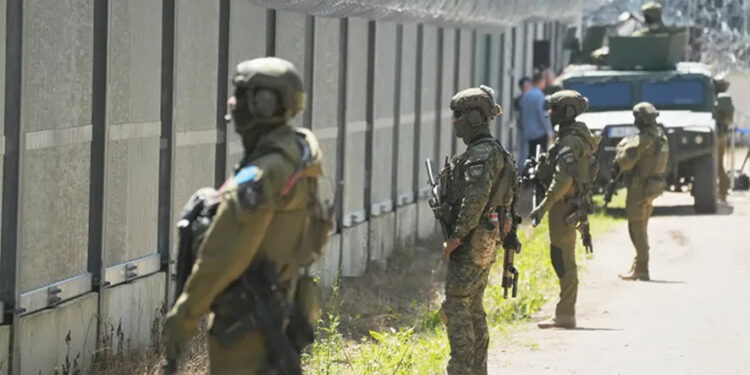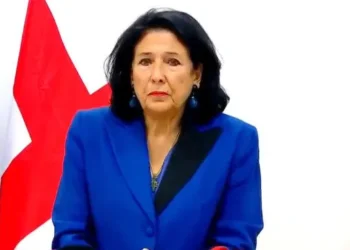The war in Ukraine took a dangerous turn this week when Russian drones crossed into NATO territory, violating Poland’s airspace in what Warsaw described as a grave act of aggression. The incident, which forced Polish and allied NATO aircraft into action, underscored the increasingly volatile nature of the conflict as heavy fighting raged across Ukraine’s eastern front, Russian strikes battered cities, and Kyiv’s drone campaign disrupted vital oil infrastructure deep inside Russia.
Polish officials say multiple drones entered their territory during a massive Russian bombardment of Ukraine. Poland’s air force confirmed it had shot down hostile aerial objects, describing them as drones that strayed across the border. In response, Polish and allied aircraft, along with ground-based air defense systems and radar reconnaissance units, were placed on the “highest state of readiness.”
While investigations are ongoing, if confirmed to be of Russian origin, the episode would mark the first time Poland has directly engaged Russian assets in its skies since the full-scale war began in 2022.
Prime Minister Donald Tusk moved quickly to reassure citizens, while escalating Poland’s security posture. He announced that the country’s two remaining border crossings with Belarus would be closed at midnight on Thursday, citing a direct threat to Polish citizens as Russia and Belarus prepare for their “Zapad-2025” joint military exercises. The drills, beginning Friday, are reportedly to include simulations of nuclear weapon use and the deployment of the new Russian-made Oreshnik intermediate-range hypersonic missile. Neighboring NATO members Lithuania and Latvia, deeply alarmed by the planned maneuvers, have also begun reinforcing their borders.
The heightened tension coincides with a brutal week of fighting on the battlefield. In one of the most devastating single strikes in recent months, a Russian air attack killed 24 elderly Ukrainians in the village of Yarova, 24 kilometers from Sloviansk, as they waited to collect their pensions. Ukrainian President Volodymyr Zelensky condemned the attack and reiterated his call for Kyiv’s allies to urgently strengthen air defense supplies. He warned that Moscow interprets the West’s failure to impose harsher sanctions as tacit permission to prolong and intensify its war.
The skies above Kyiv again came under assault as Russia launched a wave of drones at the capital early Wednesday. Ukraine’s military administration said air defense units managed to repel many of the incoming drones, though fragments caused damage and injuries in some districts. At the same time, Russia reported that its own air defense units destroyed 122 Ukrainian drones overnight, highlighting the expanding drone war that now stretches deep into Russian territory.
One such Ukrainian strike proved deadly in the Black Sea resort city of Sochi, where regional authorities confirmed that a man was killed after a drone crashed and exploded. Elsewhere, Ukrainian drone and missile attacks have inflicted serious damage on Russia’s energy infrastructure. Based on calculations by Reuters, Ukraine’s campaign against oil refineries and export facilities has knocked out at least 17 percent of Russia’s oil processing capacity—roughly 1.1 million barrels per day. These strikes have disrupted exports and forced Moscow to divert resources toward the protection and repair of critical facilities.
Russia, however, remains capable of mounting large-scale offensives. Its military has intensified operations along several sectors of the front, especially in the Donetsk and Sumy regions. Ukrainian officials report that Russian forces are attempting to press forward in rural zones near Sloviansk and Pokrovsk, using glide bombs, artillery, and waves of infantry assaults. The attack on Yarova illustrated the deadly effect of these glide bombs, which can strike from beyond the reach of many of Ukraine’s short-range defenses. Despite high Russian casualties—Ukraine claims hundreds per day in some areas—the Kremlin’s troops continue to push incrementally forward.
On the Ukrainian side, counterattacks have sought to blunt Russian momentum. Over the past month, Ukrainian forces claimed to have regained territory at a rate five times higher than the land lost, particularly in parts of Donetsk. Analysts, however, note that Russia’s overall territorial gains still outweigh Ukraine’s, with Moscow slowly consolidating control in contested zones. The Institute for the Study of War recently estimated that Russia captured more than 220 square miles of territory in August alone, though the pace of advance slowed slightly compared to earlier months.
The human cost is staggering. Along with the 24 killed in Yarova, dozens more civilians were reported injured across Ukraine this week from missile and drone strikes that set residential buildings ablaze, destroyed infrastructure, and knocked out power supplies. In Odesa and Zaporizhzhia, waves of drones caused significant damage to port facilities, complicating Ukraine’s efforts to keep grain exports flowing.
The war’s growing spillover into NATO territory has intensified diplomatic activity. Poland arrested a suspected Belarusian spy and announced the expulsion of a Belarusian diplomat accused of “supporting aggressive action” against Poland. Lithuania, which conducted military drills earlier this month with Poland and other NATO allies, has pledged to reinforce its borders with Belarus and Russia during the Zapad exercises. Western officials fear that Russia could use the drills as cover for provocations similar to this week’s drone incursion into Poland.
At the international level, calls for de-escalation are growing even as battlefield violence worsens. US President Donald Trump confirmed that he plans to speak with Russian President Vladimir Putin in the coming days, part of Washington’s ongoing effort to explore the possibility of a peace deal. The White House has not disclosed details of the proposed talks, but Ukrainian officials remain cautious, wary of any settlement that could cement Russian territorial gains.
For now, the war shows no signs of abating. Russia continues to deploy massive resources into the fight, while Ukraine leans heavily on Western support for weapons, ammunition, and air defenses. The drone war is intensifying, striking deep into both nations and increasingly spilling into neighboring states. The violation of Poland’s airspace may mark a new threshold, one that risks drawing NATO more directly into the conflict. As both sides trade blows, the frontlines remain unstable, the civilian toll rises, and Europe braces for what could be an even more perilous phase of the war.
Compiled by Ana Dumbadze














